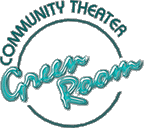|
||||||||||||||||||||||||||||||||||
Step 9: Dress ItSidebar: Telling the Story with Set Decor. Three examples of using decor to help tell the characters' story
|
Whether a realistic set or a minimal one, it's still all in the details. Here are some points to consider and some nice details you might think about adding. TextureTexture can be added through the use of textiles (rugs, cushions, upholstery, curtains, wall hangings, etc.), stone (either painted or made of styrofoam -- see our article on faux stone in the How-To section), metal (see our article on fireplace hoods for a neat burnished metal technique, in How-To), furniture surfaces, and painting techniques that imitate wood, stucco, marble, granite and any other natural texture you can think of. My favorite books on faux painting techniques are Recipes for Surfaces : Decorative Paint Finishes Made Simple and Recipes for Surfaces : New and Exciting Ideas for Decorative Paint Finishes by Mindy Drucker and Nancy Rosen. Wall stencils are a good way to add patterns, although they can be very time-consuming. Set decor items can also add texture - I particularly like to use anything made of old wood because of the warmth it adds (I've got an antique butter churn and an old music cabinet that have probably been on stage more than I have). Interesting DetailsChair rails painted in a color that contrasts with or compliments the wall color Baseboard and ceiling moldings, again in a contrasting or complimentary color. Ceiling moldings can make a set more intimate by optically lowering a "ceiling" that would otherwise soar off into the dark reaches above the stage A radiator, either the old-fashioned freestanding type made of metal (we've got one at our theater that we repaint and use over and over), or a built-in type that's simply a metal grill with molding around it, attached either to a box under a recessed window (which gives you additional seating space) or directly to a flat Small recessed areas or alcoves built into the set to hold a phone or act as a bar, painted in a contrasting color or with a faux marble technique Varnished wood, using the combination varnish-and-color mixtures available at the hardware store - nice for bars, countertops, shelves, moldings, or anywhere you want the effect of warm wood. Patterned moldings around built-in bookcases or alcoves - for an elegant touch, stain rather than paint them. Dry-brush the raised pattern part to make it stand out (if the set is supposed to be ritzy, use gilt for this) Wallpaper borders - staple them on Interesting doors - pocket doors, French doors, accordion doors, doors with frosted or stained glass insets (see our article on making your own stained glass) Columns finished or painted to resemble stone, wood or marble. Tall cardboard tubes used in the building trade for pouring concrete anchors make excellent round columns that are lightweight, take paint well, and are easy to cut to the proper height. They work best when slipped into a wooden base to hold them upright. These are available from contractor supply houses that cater to the construction business. Wood and wicker -- bowls, baskets, boxes and other containers add texture, warmth, and color You'll notice that I've used the words "warm" and "warmth" several times here. That's because, to my mind, "warm" is the most useful feeling to invoke when in attempting to make a set look like a real lived-in place rather than a theater set. So many of the plays that we produce in community theater are the traditional living room, drawing room, bar, office, etc., where real people are supposed to be living out their lives. Unless such a set contains warm elements -- varnished or antique wood, fabrics with texture, etc. -- it will look cold and uninviting. There are times, of course, when you want a set to look cold, depending on what you're supposed to be representing, but if you don't, you'll need to add elements that will warm it up. NEXT: Step
10: Adjust and Admire |
|
The
Community Theater Green Room www.communitytheater.org © 1999 - 2007 Chris & Mike Polo All rights reserved. |


